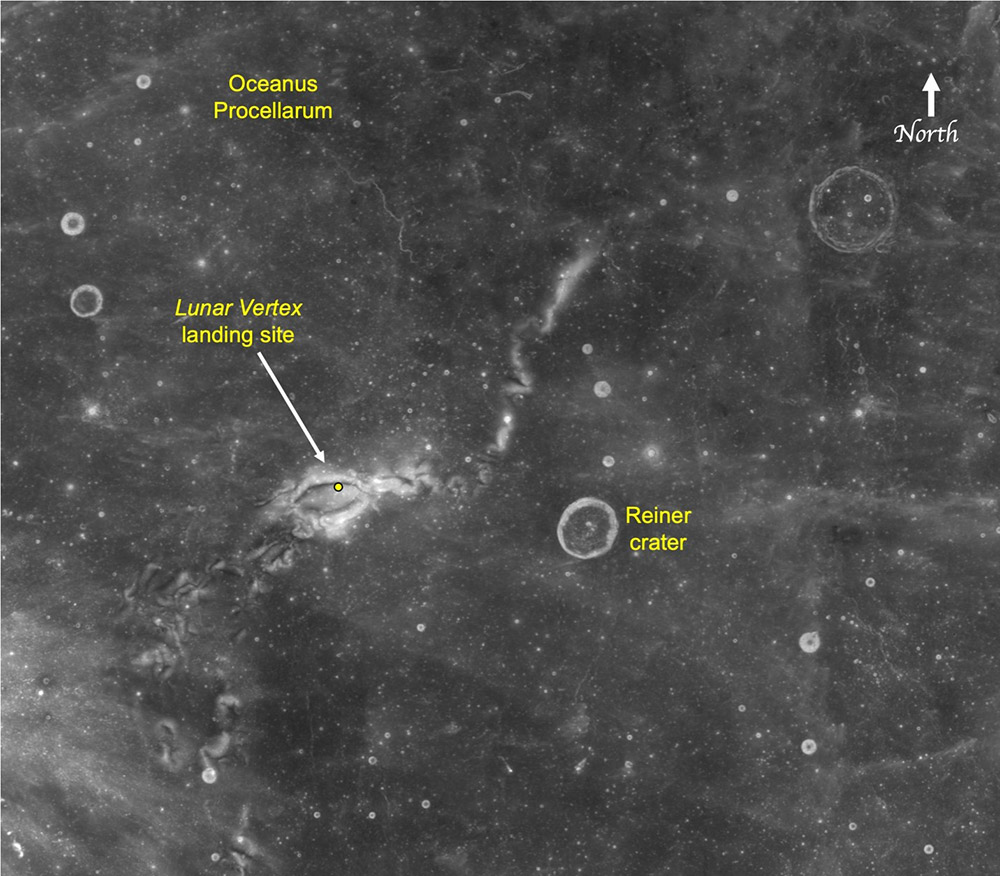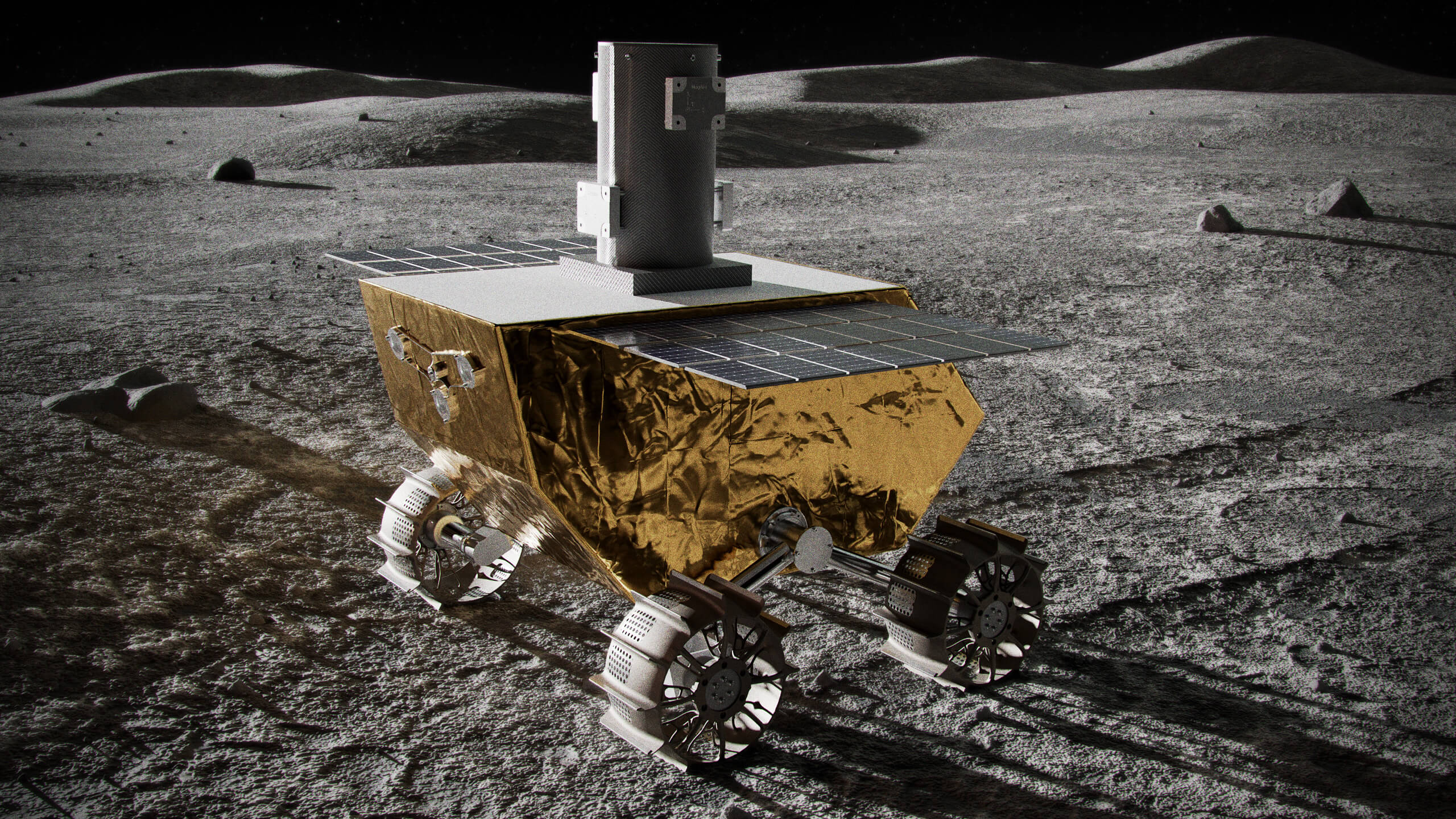News
Lunar Vertex: Solving Mysteries Swirling Around the Moon’s Magnetic Regions
First spied through primitive telescopes in the 1600s, Reiner Gamma is the most famous of the Moon’s so-called swirls, intriguing patterns of bright and dark soil that snake across the lunar surface. During the Space Age, it was discovered that the swirls coincide with swaths of magnetized rock.

Credit: NASA/Johns Hopkins APL
Scientists believe these areas can help them answer many questions about conditions on the Moon and other airless worlds throughout the solar system. To get that data, the Johns Hopkins Applied Physics Laboratory (APL) leads a project not just to visit Reiner Gamma but to drive right across it.
A NASA-provided commercial lander will deliver Lunar Vertex to a location within Reiner Gamma, where it will conduct complementary investigations both from the lander and from a small rover that will explore just over a mile (up to 2 kilometers) of the 43-mile (70-kilometer) wide surface feature. The Lunar Vertex payload includes an ion-electron plasma spectrometer and cameras that will remain on the lander, magnetometers on both the lander and rover, and a multispectral microscope on the rover.
The project combines the expertise of several leading space institutions and commercial companies. APL’s David Blewett is the principal investigator and leads the science team, which is primarily composed of APL scientists. The Lab is also providing overall management, systems engineering, safety and mission assurance, the two magnetometer instruments, and rover integration and testing. The plasma spectrometer will be provided by Southwest Research Institute, the cameras by Redwire and the microscope by Canadensys Aerospace. Lunar Outpost is building the rover.
NASA this week selected Intuitive Machines to build the lander that will deliver four payloads, including Lunar Vertex, to the Reiner Gamma region in 2024.
A Magnetic Mystery
Unlike Earth, the Moon doesn’t have a global magnetic field. Instead, it has local pockets of magnetized crust. Orbiting spacecraft, such as Lunar Prospector, Chandrayaan-1 and Chang’e 2, have also sensed mini-magnetospheres tens of kilometers above the stronger magnetic anomalies. Lunar Vertex will be the first mission to find out what these magnetic anomalies are like on the ground.
“The magnetic anomalies are superb natural laboratories,” said Blewett. “They offer a venue to examine key questions in several major areas of planetary science, from geophysics to geology to plasma physics.”
Lunar Vertex will take on some persistent lunar mysteries: the origins of these magnetic anomalies and any relation they might have to the visible swirls. The investigation will look closely at how these areas interact with the solar wind, the high-speed stream of energetic particles from the Sun.
“On most airless bodies, like the Moon, Mercury or asteroids, the solar wind streams on in and hits the surface,” Blewett said. “But these magnetic patches bend the trajectories of the solar wind, providing a bit of an umbrella that protects the surface. Because the solar wind causes the soil to darken over time, this might be the reason behind the lighter swirls.”
With the solar wind attenuated by the magnetic field, the team can examine more closely the other known source of surface-darkening space weathering: micrometeoroid impacts, which are unaffected by the magnetic patches.
“It’s like having a space-weathering control group,” Blewett said. “If we can gain a better understanding of these processes on the Moon, that will really help us understand space weathering on other bodies throughout the solar system.”
Lunar Vertex will last about 13 Earth days — landing after sunrise and ending shortly before sundown — giving the solar-powered rover enough time to traverse both the light and dark sections of the swirls and check the strength and orientation of the magnetic fields in different parts of Reiner Gamma.
Focus on Science
Combining the capabilities of a lander and rover, Lunar Vertex has several science goals:
- Investigate the origin of lunar magnetic anomalies
- Determine the structure of the mini-magnetosphere that forms over Reiner Gamma
- Investigate the origin of lunar swirls
- Evaluate the importance of micrometeoroid bombardment versus solar wind exposure in the space weathering of lunar surface materials
- Provide data on strategic knowledge gaps for human exploration
Lunar Leadership
Lunar Vertex was competitively awarded under the Payloads and Research Investigations on the Surface of the Moon (PRISM) program. PRISM solicits science investigations that will reach the Moon on commercial landers selected under the Commercial Lunar Payload Services (CLPS) program. NASA launched CLPS in 2018 to spur rapid acquisition of lunar delivery services from American companies for payloads that advance capabilities for science, exploration or commercial development of the Moon.
“APL scientists had been advocating for the science potential of lunar magnetic anomalies for many years, so we were elated when NASA designated Reiner Gamma as the landing site for the first PRISM mission,” Blewett said.
APL scientists and engineers have key roles on several CLPS programs, with the Lab providing scientific instruments; modeling, simulation, test and integration leadership; and data analyses.
The Lab also supports NASA’s Lunar Surface Innovation Initiative, which promotes the development and deployment of technologies enabling humans to live and work on the Moon. The initiative includes the APL-led Lunar Surface Innovation Consortium, a nationwide alliance of more than 300 universities, nonprofit research institutions, commercial companies, NASA centers and program offices, and other government agencies with a vested interest in the nation’s campaign to establish a sustained presence on the Moon.
Lunar Vertex: What’s in a Name?
The project’s name adopts the Latin “vertex,” which can mean “swirl.” The English word “vertex” invokes an intersection — describing this interdisciplinary exploration at the crossroads of geoscience and space physics.
